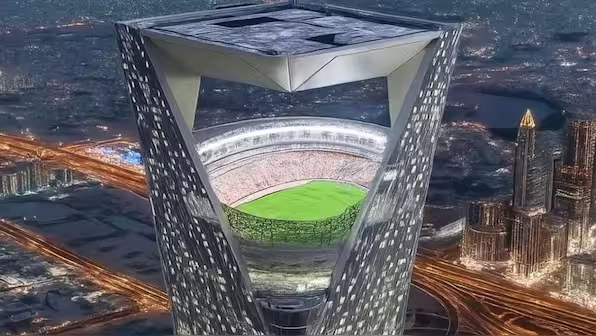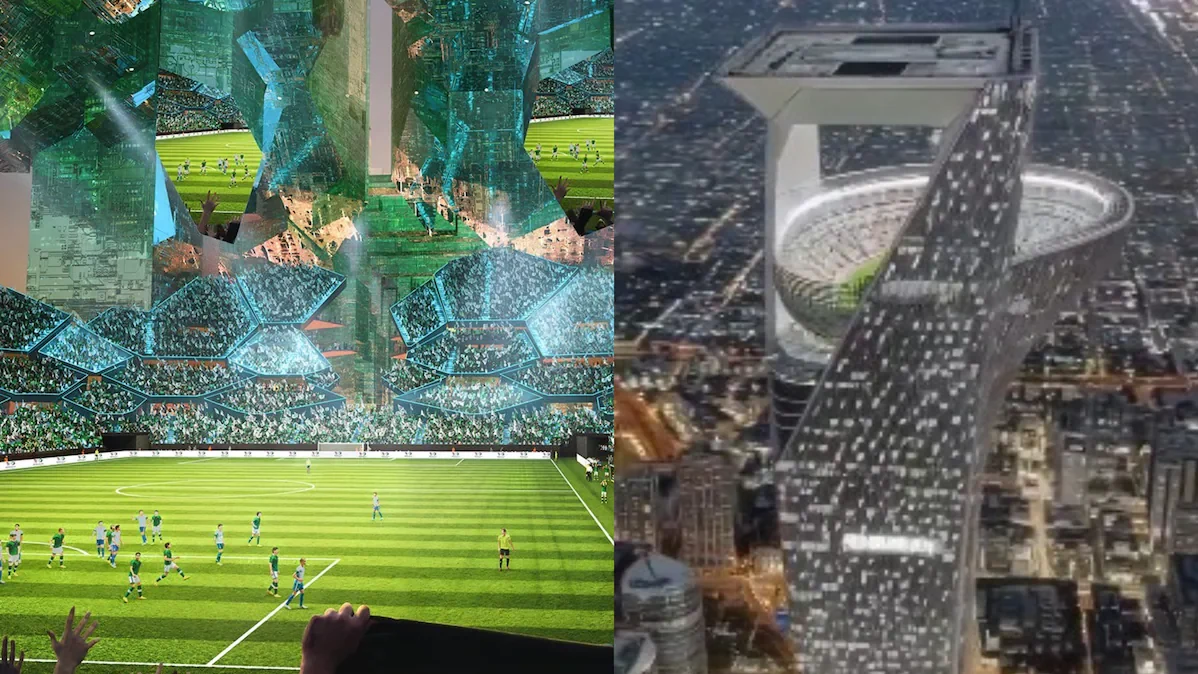Vision That Soars
In the shimmering desert horizons of northwestern Saudi Arabia, a bold dream is taking shape one that promises not just a stadium, but an architectural statement to the world. The kingdom is planning the one and only “sky stadium” for the forthcoming 2034 FIFA World Cup, a venue suspended some 350 meters above the desert floor, slated to become the world’s first of its kind.
The name behind it is NEOM, a futuristic mega city rising from the Saudi desert, and within it the proposed stadium that will be integrated into the roof of the city’s linear architecture. It’s a symbol of ambition, for sport, for innovation, and for the nation’s place on the global stage.
Engineering the Extraordinary
Imagine entering a massive high-speed elevator, ascending through the steel and glass spine of a futuristic megastructure, and arriving at the level of the stadium bowl the pitch spread before you, lights glinting like stars, the desert wind beneath your feet. That is the essence of the project.
The planned stadium will seat around 46,000 spectators, powered entirely by renewable energy from solar and wind sources, with construction expected to begin around 2027 and wrap up by 2032 just in time for the 2034 tournament.
Experts note that viral images of a floating stadium are largely AI-enhanced concept visuals, and the reality will be slightly more grounded. The venue will sit inside the structure of NEOM’s “The Line,” rather than literally hovering in midair. Yet the promise remains breathtaking.
A Statement of Sustainability and Innovation
This stadium isn’t just about spectacle. It aligns with the broader ambitions of the kingdom’s transformation. By powering the venue with renewable energy and embedding smart systems, Saudi Arabia signals that the future of sport can be both grand and green.
Beyond energy, the stadium design carries high-tech features such as AI-driven fan experiences, augmented reality overlays, advanced acoustics, and seamless connectivity. In short, it is meant not only to host matches but to redefine what a stadium can be in the 21st century.
What It Means for Football and Fandom
For fans, this represents a remarkable shift. Instead of a traditional bowl perched at ground level, this is a new kind of experience. Attending matches at a stadium hundreds of meters above the desert floor will be extraordinary the venue itself becoming a part of the memory, not just the game played within.
It will also send a signal to the football world that major tournaments can evolve, that venues can be more than just arenas they can become icons.
The venue is expected to host group stage matches, round of 32, round of 16, and quarterfinal fixtures of the 2034 World Cup. This means the sky stadium will play a central role in one of sport’s greatest global shows.

The Larger Picture: Transformation Through Sport
This grand stadium sits within a much larger narrative. Saudi Arabia’s hosting of the 2034 World Cup itself is part of a vision to diversify the economy, elevate international presence, and unlock new opportunities for tourism, culture, and sport.
By building such standout infrastructure, the kingdom is staking a claim not just as a host but as a pioneer. In this way, the stadium becomes more than a venue it becomes a symbol of progress, change, and ambition.
The potential is huge: thousands of jobs, global media attention, fans from every continent converging, and a legacy that extends long past the final whistle.

Challenges and Realistic Expectations
Of course, with ambition comes risk. Engineers caution that constructing a massive stadium at such altitude, in a desert environment, presents significant challenges in structural safety, climate control, accessibility, and cost.
Timing may also be tight, with completion targeted by 2032 and the tournament in 2034, leaving little room for delay. Some viral imagery misconstrues the project and ensuring clarity between concept and reality is key.
Nonetheless, the groundwork is laid and the momentum appears strong.
Legacy Beyond 2034
What happens after the tournament? Smart planning suggests the stadium will have life beyond the World Cup. It is envisioned as a multipurpose venue for sport, entertainment, concerts, and even as the home ground for future professional clubs within NEOM.
In the end, the goal is not just to host a once-in-a-lifetime event, but to craft a living asset a structure embedded in the city, in the culture, in the everyday lives of people for years to come.
Why This Matters to the World
In a globalized era where sports tourism, broadcast rights, fan experience, and sustainability all converge, the stadium becomes a signal of what’s possible. It reminds us that venues can lead storytelling, that architecture can be part of spectacle, and that sports events can shape future generations.
For football lovers, for architects, and for fans imagining being in the stands one day with skies above and deserts below, this is a moment of anticipation.
And for Saudi Arabia, this is a chance to shine not only on the pitch but in hearts around the world.
Final Thoughts
When the world’s best footballers stride onto the pitch of what may become the world’s first sky stadium in 2034, they will not only play a game; they will step into history.
In that moment, fans will not just remember who scored or who won they will remember where they sat, what they saw, and how high above it all they stood.
This isn’t just a stadium. It’s a dream proclaimed in steel and sky. And the countdown to the future has already begun.
Do follow Gulf Magazine on Instagram.
Also Read – Lee Jung Jae Urges Saudi Billionaires to Invest in Korea’s Growing Entertainment Power



